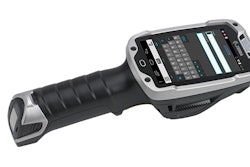Plans to develop reader modules, tags using technology for reading multiple tags in tightly packed or dynamic environments
Vernon Hills, IL — July 12, 2006 — Auto-ID specialist Zebra Technologies has licensed Magellan's Phase Jitter Modulation (PJM) radio frequency identification (RFID) technology with the intention of developing and commercializing RFID reader modules and tags that incorporate the PJM technology.
In 2006, Zebra plans to embed the reader modules in its printer/encoder products to enable more efficient programming of smart labels and tags.
Ratified in 2004, PJM is a high-frequency RFID system specified in an existing global standard, ISO/IEC 18000-3 mode 2, RFID for Item Management. Because the technology is optimized for applications where many hundreds of tags are packed tightly or need to be read reliably in dynamic situations, it is an ideal solution for pharmaceutical e-pedigree, document control, gaming and other applications, according to Zebra.
"We have been collaborating with Magellan for many years, and their PJM technology has demonstrated unique performance advantages in meeting customer requirements in demanding applications like item-level tagging," said Bob Cornick, vice president and general manager of RFID for Zebra Technologies. "Incorporating PJM capabilities into our high frequency RFID line will provide customers with the products they need to achieve the exceptionally high read accuracy and data transfer rates required in these applications."
Magellan Technology, based in Sydney, Australia, is a technology developer, manufacturer and licensor of advanced read and write 13.56MHz RFID systems. Magellan designs and offers RFID chips, inlets and a reader portfolio (multi channel, multi antenna, tunnel and tray readers) and operating software.
Additional Articles of Interest
— Contemplating RFID? Here are three critical questions to answer before embarking on a radio frequency identification initiative. Read "Recognizing Real RFID Adoption Potential," in the February/March 2006 issue of Supply & Demand Chain Executive.
— A recent independent study revealed that Wal-Mart customers are finding the items they wanted in stock more often due to the retailer's use of RFID technologies when compared to control stores. Read more in "Wal-Mart Achieving Improved On-shelf Availability with RFID, Study Finds" on SDCExec.com.
Vernon Hills, IL — July 12, 2006 — Auto-ID specialist Zebra Technologies has licensed Magellan's Phase Jitter Modulation (PJM) radio frequency identification (RFID) technology with the intention of developing and commercializing RFID reader modules and tags that incorporate the PJM technology.
In 2006, Zebra plans to embed the reader modules in its printer/encoder products to enable more efficient programming of smart labels and tags.
Ratified in 2004, PJM is a high-frequency RFID system specified in an existing global standard, ISO/IEC 18000-3 mode 2, RFID for Item Management. Because the technology is optimized for applications where many hundreds of tags are packed tightly or need to be read reliably in dynamic situations, it is an ideal solution for pharmaceutical e-pedigree, document control, gaming and other applications, according to Zebra.
"We have been collaborating with Magellan for many years, and their PJM technology has demonstrated unique performance advantages in meeting customer requirements in demanding applications like item-level tagging," said Bob Cornick, vice president and general manager of RFID for Zebra Technologies. "Incorporating PJM capabilities into our high frequency RFID line will provide customers with the products they need to achieve the exceptionally high read accuracy and data transfer rates required in these applications."
Magellan Technology, based in Sydney, Australia, is a technology developer, manufacturer and licensor of advanced read and write 13.56MHz RFID systems. Magellan designs and offers RFID chips, inlets and a reader portfolio (multi channel, multi antenna, tunnel and tray readers) and operating software.
Additional Articles of Interest
— Contemplating RFID? Here are three critical questions to answer before embarking on a radio frequency identification initiative. Read "Recognizing Real RFID Adoption Potential," in the February/March 2006 issue of Supply & Demand Chain Executive.
— A recent independent study revealed that Wal-Mart customers are finding the items they wanted in stock more often due to the retailer's use of RFID technologies when compared to control stores. Read more in "Wal-Mart Achieving Improved On-shelf Availability with RFID, Study Finds" on SDCExec.com.
- More articles about Zebra Technologies.












